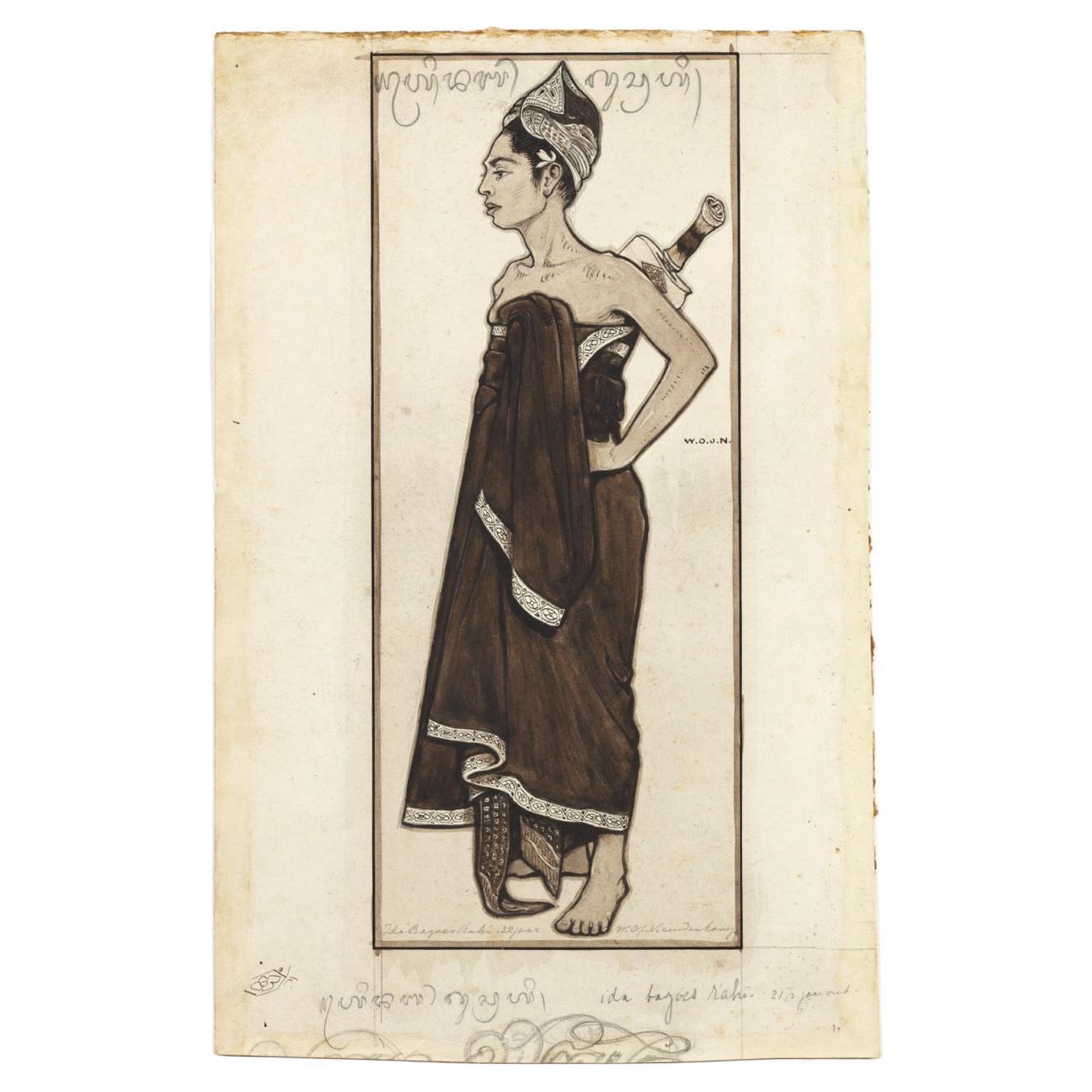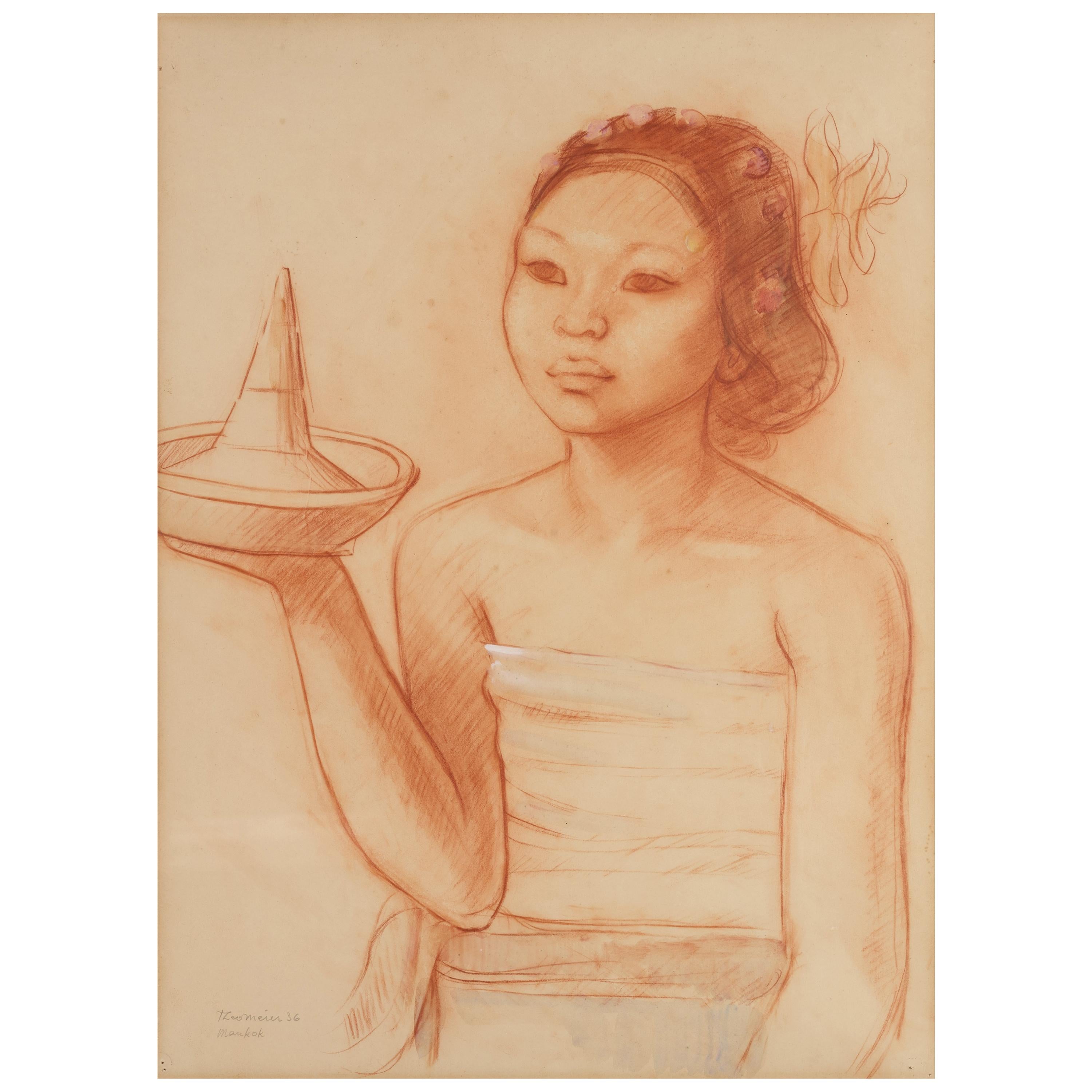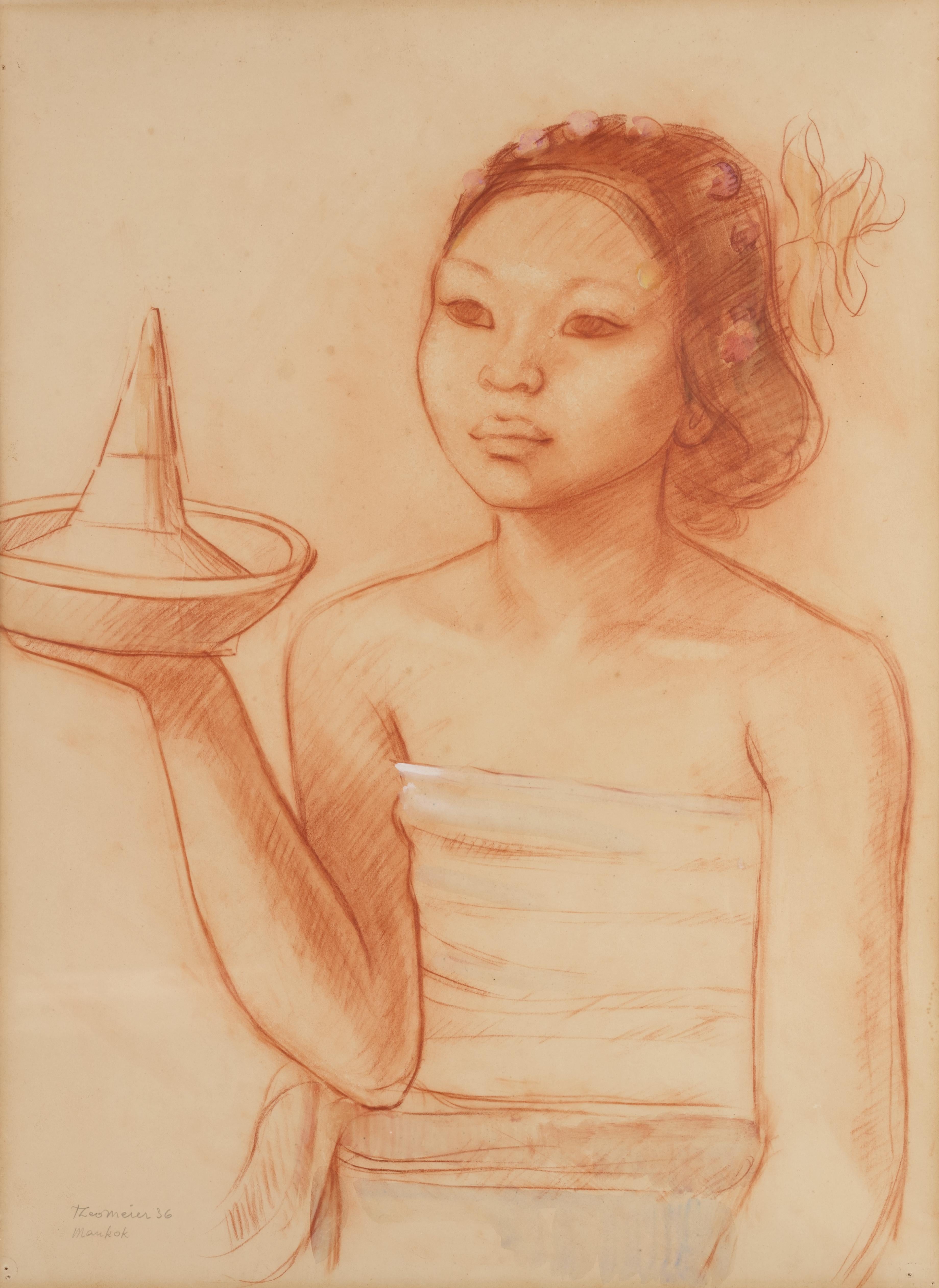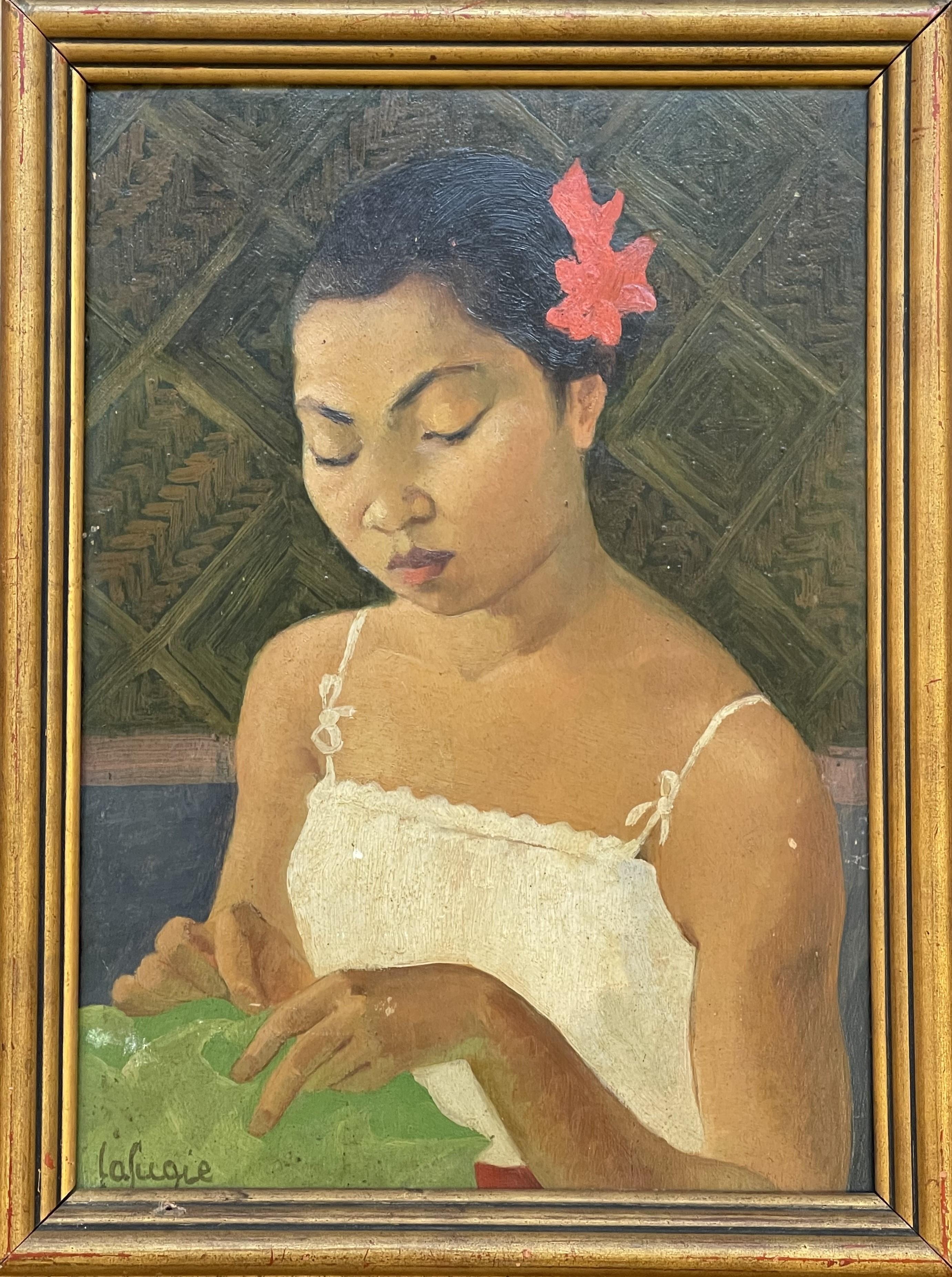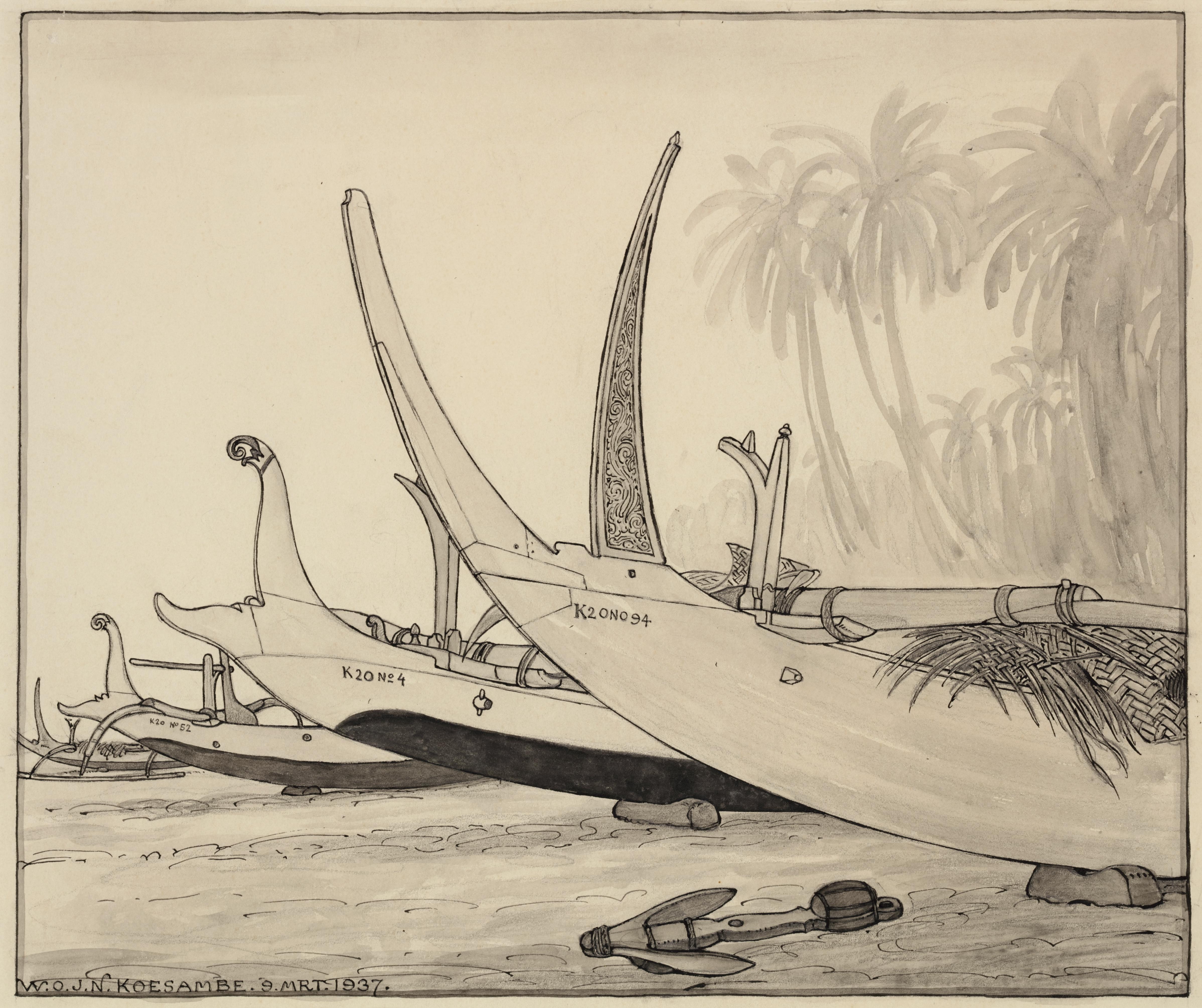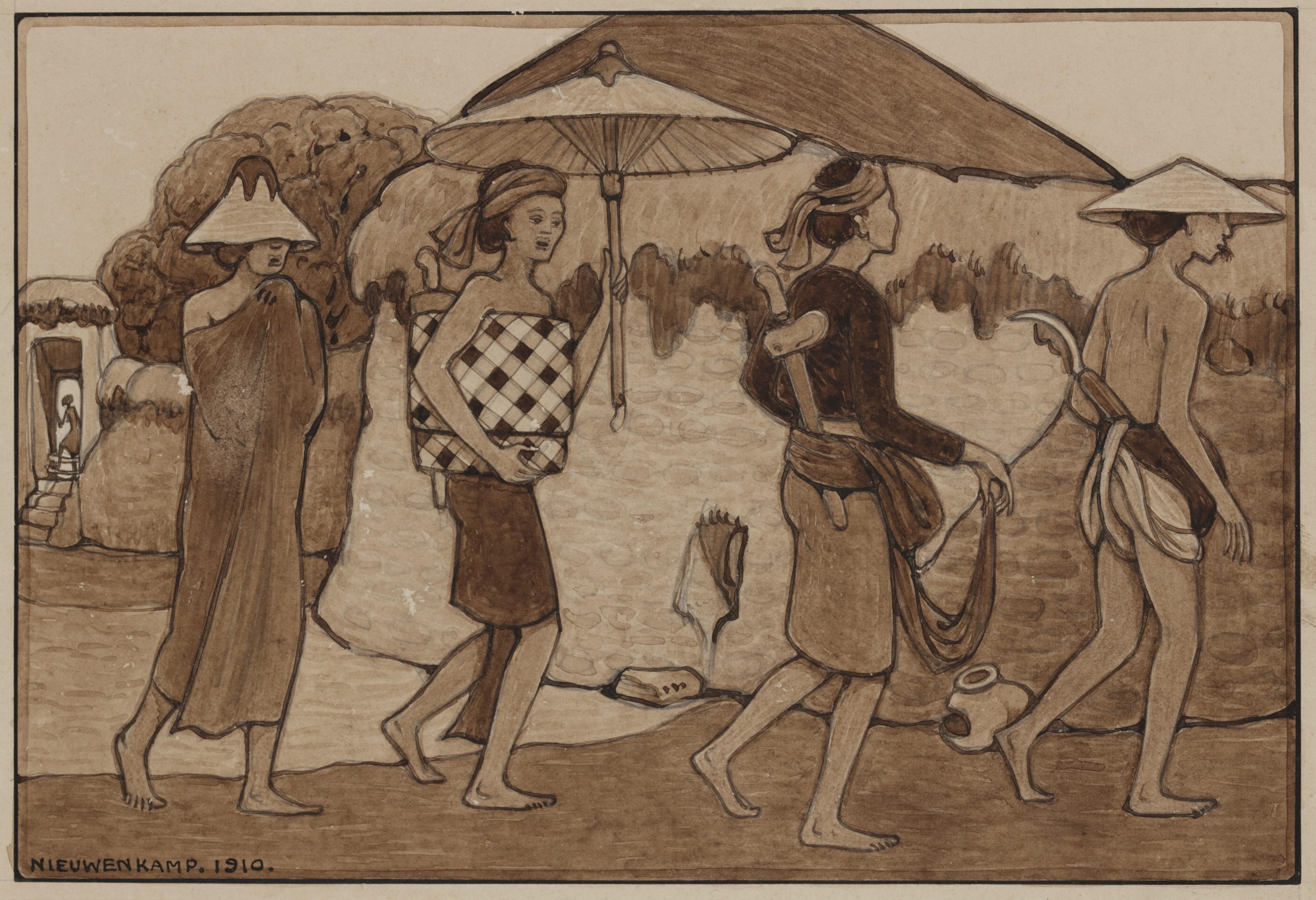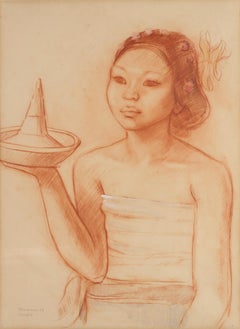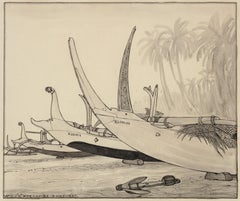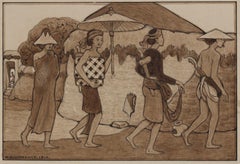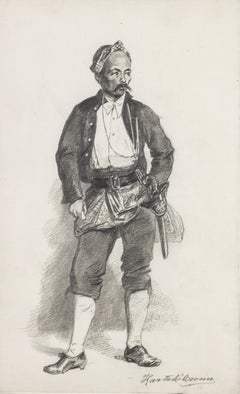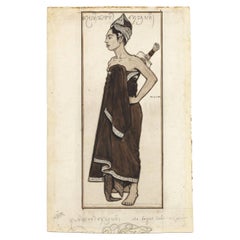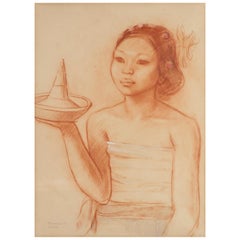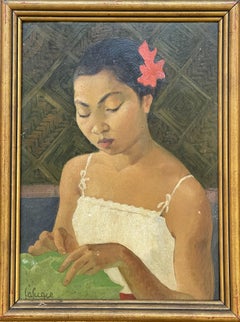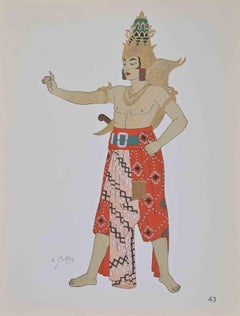Items Similar to Portrait of artist Ida Bagoes Ketut Diding, Bali, 1937
Want more images or videos?
Request additional images or videos from the seller
1 of 7
W.O.J. NieuwenkampPortrait of artist Ida Bagoes Ketut Diding, Bali, 19371937
1937
$22,883.90
£16,945.39
€19,200
CA$31,468.80
A$35,001.39
CHF 18,318.98
MX$426,901.53
NOK 230,184.62
SEK 216,518.35
DKK 146,175.52
About the Item
Ida Bagoes Ketut Diding, Artist on bali 1937
Signed with initials, dated and titled, bottom centre
Black chalk on paper, 29 x 31 cm
Literature:
Ernst Braches en J.F. Heijbroek, W.O.J. Nieuwenkamp, Bouwstoffen, toegepaste grafiek en illustraties, Amsterdam 2016, p. 160
Black ebonized frame with white mount
Willem Otto Wijnand Nieuwenkamp (1874-1950)
Nieuwenkamp was born on July 27th 1874 in Amsterdam. His father owned sailing ships sailing to Indonesia and hearing the stories of the returning captains evoked in the young Nieuwenkamp an obsession for distant lands and adventure. After a failed attempt by his father to have his son make a career in his business, Nieuwenkamp attended the Academy for Decorative Art in Amsterdam. However, he left within one year to go his own way.
He was an autodidact and a great experimenter with new techniques, particularly in the art of etching. Nieuwenkamp was a very focused man with the discipline of a scientist tempered by the sensitivity of an artist, a lust for adventure, a natural appreciation for ethnic arts and an enormous ambition to tread new paths.
In 1898 he visited Indonesia for the first time and on his second visit in 1903-1904 he went on to Bali and became the first foreign artist to love Bali and the Balinese with a passion. Having secured agreements with several museums in the Netherlands to obtain Balinese art and objects for their collections, Nieuwenkamp immediately started to purchase and order a wide range of ethnographic art and objects from local artists and craftsmen.
Through his drawings and books, he gave an excellent impression of Balinese art and culture at that time. Since 1854 Northern Bali was under Dutch rule but Southern Bali in 1904, when Nieuwenkamp visited it, was still independent. Nieuwenkamp would be one of the last Westerners to experience a glorious medieval society in its final days. During his second visit to Bali in 1906 the Dutch decided to end the independence of South Bali and Nieuwenkamp was invited by the Governor-General van Heutz to accompany the Dutch invasion force. By contemporary European standards, the Balinese were barbarous and primitive, particularly with widows throwing themselves in the flames of the funeral pyre of their deceased husbands. But Nieuwenkamp was a singular man who saw in their society the beauty and soul that had been lost in his own.
On September 20th, 1906, Denpasar, the capital of South Bali fell to the Dutch military forces. Official military briefings praised the victory which was reported with nationalistic pride on the front pages of all Dutch newspapers. As Nieuwenkamp had witnessed, the truth was far from glorious. As if in trance the Balinese, men women and children, dressed in their finest silks and jewellery and armed with ancient bejewelled krises, the Raja himself mounted atop a golden palanquin, rushed forward, the men killing their wives and children and the Dutch machinegun fire doing the rest. The once-powerful and magnificent court of Denpasar was left in ashes and as many as two thousand Balinese dead. The Dutch suffered four deads.
Nieuwenkamp made drawings and saved as many beautiful architectural elements and artefacts from the rubbles as he could, most of it now in the collection of the Ethnological Museum in Leiden.
- Creator:W.O.J. Nieuwenkamp (1874 - 1950, Dutch, Indonesian)
- Creation Year:1937
- Dimensions:Height: 11.42 in (29 cm)Width: 12.21 in (31 cm)Depth: 1.19 in (3 cm)
- More Editions & Sizes:29 x 31 cmPrice: $20,023
- Medium:
- Movement & Style:
- Period:
- Framing:Frame IncludedFraming Options Available
- Condition:
- Gallery Location:Amsterdam, NL
- Reference Number:1stDibs: LU147128029902
About the Seller
No Reviews Yet
Vetted Professional Seller
Every seller passes strict standards for authenticity and reliability
1stDibs seller since 2021
- ShippingRetrieving quote...Shipping from: Amsterdam, Netherlands
- Return Policy
Authenticity Guarantee
In the unlikely event there’s an issue with an item’s authenticity, contact us within 1 year for a full refund. DetailsMoney-Back Guarantee
If your item is not as described, is damaged in transit, or does not arrive, contact us within 7 days for a full refund. Details24-Hour Cancellation
You have a 24-hour grace period in which to reconsider your purchase, with no questions asked.Vetted Professional Sellers
Our world-class sellers must adhere to strict standards for service and quality, maintaining the integrity of our listings.Price-Match Guarantee
If you find that a seller listed the same item for a lower price elsewhere, we’ll match it.Trusted Global Delivery
Our best-in-class carrier network provides specialized shipping options worldwide, including custom delivery.More From This Seller
View All“A Balinese woman with offerings” (1936)
By Theo Meier
Located in Amsterdam, NL
Theo Meier (1908-1982)
“A Balinese woman with offerings”
Signed, dated '36 and annotated Mankok (the name of the sitter) lower left
Sanguine on paper, measures: 57 x 41.5 cm
In a handmade and hand painted frame with address: Max Kno¨ll, Herberggasse 4/1, Basel.
Provenance:
Private collection, Basel (acquired directly from the artist)
Private collection, London
Note:
Theo Meier was born in Basel, where he attended art school and became a successful portrait painter. However, after visiting an exhibition in Basel of Tahitian paintings by Paul Gaugin, he decided to follow in Gaugin’s footsteps and go to the South Pacific. To finance his voyage, he founded a club in which every member pledged a monthly sum in return of which they could choose one of Meier’s paintings upon his return.
In 1932, at the age of 24, he embarked on his voyage to the South Sea. In Tahiti, he certainly discovered the beauty of the colours of the tropical world but the simplicity of the inhabitants, he had seen in Gaugin’s paintings turned out to be more in the artist’s fantasy than in reality. He returned to Basel but in 1935 again was on his way to the South Sea. In 1936 he arrived in Bali, planning to stay there for two or three weeks, but thirty years later he was still there. In Bali “a delirium laid hold of me which even today has not subsided”, he was to write much later. The present drawing was made during his first “delirius” year in Bali. In Bali, he settled and found inspiration and friendship with other artists including Walter Spies...
Category
1930s Expressionist Portrait Drawings and Watercolors
Materials
Paper, Crayon
Beach of Kusambe, Bali 1937
Located in Amsterdam, NL
Four outrigger proa’s on the beach of Kusambe, Bali, 1937
Signed with initials, dated and described with location bottom left
Pencil and ink on paper, 29.7 x 35 cm
In ebonized frame with white mount
WILLEM OTTO WIJNAND NIEUWENKAMP
(1874-1950)
Nieuwenkamp was born on July 27th 1874 in Amsterdam. His father owned sailing ships sailing to Indonesia and hearing the stories of the returning captains evoked in the young Nieuwenkamp an obsession for distant lands and adventure. After a failed attempt by his father to have his son make a career in his business, Nieuwenkamp attended the Academy for Decorative Art in Amsterdam. However, he left within one year to go his own way.
He was an autodidact and a great experimenter with new techniques, particularly in the art of etching. Nieuwenkamp was a very focused man with the discipline of a scientist tempered by the sensitivity of an artist, a lust for adventure, a natural appreciation for ethnic arts and an enormous ambition to tread new paths.
In 1898 he visited Indonesia for the first time and on his second visit in 1903-1904 he went on to Bali and became the first foreign artist to love Bali and the Balinese with a passion. Having secured agreements with several museums in the Netherlands to obtain Balinese art and objects for their collections, Nieuwenkamp immediately started to purchase and order a wide range of ethnographic art and objects from local artists and craftsmen.
Through his drawings and books, he gave an excellent impression of Balinese art and culture at that time. Since 1854 Northern Bali was under Dutch...
Category
1930s Art Nouveau Landscape Drawings and Watercolors
Materials
Paper, India Ink, Pencil
Four Balinese, Bali (1910)
Located in Amsterdam, NL
Four Balinese, 1910
Signed and dated bottom left
Pencil and ink on paper, 15.6 x 23 cm
In ebonized frame with white mount.
Literature:
W.O.J. Nieuwenkamp, Zwerftochten op Bali, Amsterdam, 1910, p. 36
WILLEM OTTO WIJNAND NIEUWENKAMP
(1874-1950)
Nieuwenkamp was born on July 27th 1874 in Amsterdam. His father owned sailing ships sailing to Indonesia and hearing the stories of the returning captains evoked in the young Nieuwenkamp an obsession for distant lands and adventure. After a failed attempt by his father to have his son make a career in his business, Nieuwenkamp attended the Academy for Decorative Art in Amsterdam. However, he left within one year to go his own way.
He was an autodidact and a great experimenter with new techniques, particularly in the art of etching. Nieuwenkamp was a very focused man with the discipline of a scientist tempered by the sensitivity of an artist, a lust for adventure, a natural appreciation for ethnic arts and an enormous ambition to tread new paths.
In 1898 he visited Indonesia for the first time and on his second visit in 1903-1904 he went on to Bali and became the first foreign artist to love Bali and the Balinese with a passion. Having secured agreements with several museums in the Netherlands to obtain Balinese art...
Category
1910s Art Nouveau Landscape Drawings and Watercolors
Materials
Paper, Pencil
European Artist - Indonesian Portraits of Mas Marco Kartodikromo, 1890-1932
Located in Amsterdam, NL
European artist (early 20th century)
Two study portraits of Mas MarCo Kartodikromo (1890-1932)
One inscribed Kartodikromo lower right
Framed in ebonized frame with white mount.
Pe...
Category
Early 20th Century Romantic Portrait Drawings and Watercolors
Materials
Paper, Crayon
Incoming Rain, Bali, 1937
Located in Amsterdam, NL
Incoming rain, Den Pasar, Bali 1937
Signed with initials, dated and titled, bottom right
Black chalk and ink on paper, 42 by 46 cm
Literature:
Ernst Braches en J.F. Heijbroek, W.O...
Category
1930s Art Nouveau Landscape Drawings and Watercolors
Materials
Paper, Graphite
Wobbly bridge, Tabanan, Bali, 1937
Located in Amsterdam, NL
Wobbly bridge, Tabanan, Bali, 1937
Signed with initials bottom right and dated, bottom left
Pencil and ink on paper, 22 x 26.3 cm
In ebonized frame with white mount
Willem Otto Wi...
Category
1930s Art Nouveau Landscape Drawings and Watercolors
Materials
Paper, India Ink, Pencil
You May Also Like
W.O.J. Nieuwenkamp (1874-1950) 'Ida Bagoes Raki, Bali 1906’
Located in Amsterdam, NL
'Ida Bagoes Raki, Bali 1906’
Signed middle right, annotated at the bottom and with artist’s stamp verso
Pen, brush and ink on paper, H. 26.3 x W. 10.8 cm
Ida Bagoes Raki, here 22 y...
Category
Early 20th Century Indonesian Paintings and Screens
Materials
Paper
Portrait of a Balinese Beauty by Theo Meier in Original Frame
Located in Amsterdam, NL
Theo Meier (1908-1982)
“A Balinese woman with offerings”
Signed, dated '36 and annotated Mankok (the name of the sitter) lower left
Sanguine on paper, measures: 57 x 41.5 cm
In a handmade and hand painted frame with address: Max Kno¨ll, Herberggasse 4/1, Basel.
Provenance:
Private collection, Basel (acquired directly from the artist)
Private collection, London
Note:
Theo Meier was born in Basel, where he attended art school and became a successful portrait painter. However, after visiting an exhibition in Basel of Tahitian paintings by Paul Gaugin, he decided to follow in Gaugin’s footsteps and go to the South Pacific. To finance his voyage, he founded a club in which every member pledged a monthly sum in return of which they could choose one of Meier’s paintings upon his return.
In 1932, at the age of 24, he embarked on his voyage to the South Sea. In Tahiti, he certainly discovered the beauty of the colours of the tropical world but the simplicity of the inhabitants, he had seen in Gaugin’s paintings turned out to be more in the artist’s fantasy than in reality. He returned to Basel but in 1935 again was on his way to the South Sea. In 1936 he arrived in Bali, planning to stay there for two or three weeks, but thirty years later he was still there. In Bali “a delirium laid hold of me which even today has not subsided”, he was to write much later. The present drawing was made during his first “delirius” year in Bali. In Bali, he settled and found inspiration and friendship with other artists including Walter Spies...
Category
Early 20th Century Balinese Dutch Colonial Paintings and Screens
Materials
Other
Léa LAFUGIE (1890-1972), portrait of a young Cambodian woman
Located in Paris, FR
Léa Lafugie was a French painter born in Paris, known for her portraits and landscapes inspired by her travels. She studied at the National School of Decorative Arts in Paris and lat...
Category
1920s Art Deco Portrait Paintings
Materials
Oil, Board
Indonesian Costume - Lithograph by Emile Gallois - Mid-20th Century
Located in Roma, IT
Lithograph and pochoir realized by Emile Gallois in the mid-20th Century ca. to illustrate indonesian costumes.
Signed in the plate.
Published by H. Laurens, Paris.
Very good cond...
Category
Mid-20th Century Modern Figurative Prints
Materials
Lithograph
Indonesian Costume - Lithograph by Emile Gallois - Mid-20th Century
Located in Roma, IT
Lithograph and pochoir realized by Emile Gallois in the mid-20th Century ca. to illustrate indonesian costumes.
Signed in the plate.
Published by H. Laurens, Paris.
Very good cond...
Category
Mid-20th Century Modern Figurative Prints
Materials
Lithograph
Indonesian Costume - Lithograph by Emile Gallois - Mid-20th Century
Located in Roma, IT
Lithograph and pochoir realized by Emile Gallois in the mid-20th Century ca. to illustrate indonesian costumes.
Signed in the plate.
Published by H. Laurens, Paris.
Very good cond...
Category
Mid-20th Century Modern Figurative Prints
Materials
Lithograph
More Ways To Browse
1937 Painting
Ethnographic Art
Bali Art
Portrait Of Captain
Captain Portrait
Bali Painting
Paintings Of Bali
1930 Portrait Etching
Primitive Paintings Of Children
Indonesian Landscape
Dutch Sailing Ship
Vintage Art Nouveau Dress
Watercolor Silk Dress
Balinese Painting Bali
Vintage Balinese Painting
Large Figurative Paintings
Original Line Art
Whimsical Art
